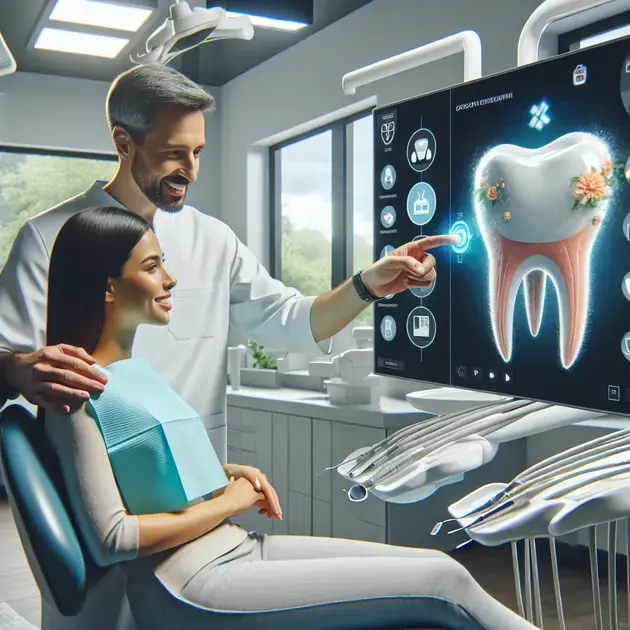In today’s world, having a thorough understanding of mouth cavities, including their causes, symptoms, and treatment, is crucial for maintaining good oral health. Cavities, also known as dental caries, are one of the most common chronic diseases worldwide.
According to the American Dental Association (ADA), the primary cause of cavities is plaque, a sticky film of bacteria that forms on teeth. When sugars from food and drinks interact with these bacteria, they produce acids that attack tooth enamel, leading to the formation of cavities. Recognizing the early symptoms of cavities such as tooth sensitivity, pain, or visible holes in the teeth can help in timely diagnosis and effective treatment.

Understanding Early Signs
Early signs of dental issues can often go unnoticed, leading to more severe problems down the line. It’s important to be aware of these signs to prevent further complications and maintain good oral health. One effective way to stay informed about early signs is by regularly visiting a dentist for check-ups. Dentists can detect subtle signs that may not be visible to the naked eye.
Another important step is to educate yourself on common early signs of dental problems. Websites like WebMD and the American Dental Association provide valuable information on symptoms to look out for. By familiarizing yourself with these signs, you can take proactive measures to address any issues that may arise.
Monitoring your dental health at home is also crucial. Using apps like Dental Expert or Oral-B’s interactive tools can help you track changes in your oral health and identify any potential problems early on. These apps provide tips on maintaining good oral hygiene and offer guidance on when to seek professional help.
Early signs of dental issues can vary from sensitivity and pain to swollen gums and bad breath. By paying attention to these signs and taking prompt action, you can prevent minor issues from escalating into major dental problems. Remember, early detection is key to maintaining a healthy smile.
Regular dental cleanings and check-ups, along with self-monitoring at home, can help you stay on top of your oral health and address any concerns before they worsen. By understanding the early signs of dental issues, you can take control of your oral hygiene and ensure a bright and healthy smile for years to come.
Preventive Dental Care
Importance of Preventive Care
Preventive dental care plays a crucial role in maintaining good oral health and preventing serious dental issues. By adopting preventive measures, such as regular brushing and flossing, along with routine dental check-ups, you can avoid the need for extensive treatments down the line. Preventive care focuses on promoting oral hygiene and addressing any potential problems before they escalate.
Steps for Preventive Care
One of the key steps in preventive dental care is maintaining a consistent oral hygiene routine. This includes brushing your teeth twice a day with a fluoride toothpaste and flossing daily to remove plaque and food particles. Additionally, using an antimicrobial mouthwash can help reduce bacteria in the mouth and prevent cavities.
Another important aspect of preventive care is watching your diet and limiting sugary and acidic foods and beverages. These can contribute to tooth decay and other dental issues. Websites like the Mayo Clinic offer detailed guidelines on a tooth-friendly diet and its impact on oral health.
Regular visits to the dentist for professional cleanings and check-ups are essential for preventive care. Websites like Healthgrades can help you find a reputable dentist in your area for regular visits. Dentists can identify early signs of dental problems and provide personalized recommendations for maintaining good oral health.
Incorporating preventive care habits into your daily routine and seeking professional dental care are key steps in preserving your oral health. By being proactive and diligent in your oral hygiene practices, you can enjoy a healthy smile and prevent the need for extensive dental treatments in the future.
Effective Treatment Options
Overview of Treatment Options
When dental issues arise, having access to effective treatment options is essential for restoring oral health. From minor procedures like fillings to more complex treatments such as root canals, dentists offer a range of solutions to address various dental concerns. Understanding these treatment options can help you make informed decisions about your oral health.
Common Treatment Procedures
One of the most common treatment options in dentistry is dental fillings, which are used to treat cavities and restore damaged teeth. Websites like Colgate provide detailed information on the different types of fillings available, from amalgam to composite materials, and their pros and cons.
For more severe cases of tooth decay or infection, root canals may be necessary to save a damaged tooth. Websites like WebMD offer in-depth explanations of the root canal procedure, including what to expect during the treatment and recovery process.
In cases of missing teeth, dental implants are a popular and effective treatment option for restoring both function and aesthetics. Websites like Dental Implants Guide offer comprehensive information on the implant procedure, including costs, benefits, and potential risks.
Orthodontic treatments, such as braces or aligners, are effective options for correcting misaligned teeth and bite issues. Websites like Invisalign provide valuable resources on the different orthodontic treatments available and their advantages in achieving a straighter smile.
By exploring the various treatment options offered by dentists and understanding their benefits and considerations, you can make informed choices about your dental care. Consulting with a dental professional and seeking reputable sources of information can help you navigate the world of dental treatments and find the best solutions for your oral health needs.

Identifying Common Risk Factors
Identifying common risk factors for oral health issues is crucial for maintaining a healthy smile. One of the most prevalent risk factors is poor oral hygiene habits, which can lead to a buildup of plaque and bacteria in the mouth. This can result in cavities, gum disease, and other oral health problems. Additionally, diet plays a significant role in oral health, with sugary and acidic foods and drinks increasing the risk of tooth decay.
Another common risk factor is smoking or the use of tobacco products. Smoking not only stains the teeth and contributes to bad breath, but it also significantly increases the risk of gum disease and oral cancer. Poorly fitting dental restorations or orthodontic appliances can also pose a risk, as they may trap food particles and bacteria, leading to decay or inflammation.
Age and genetics can also play a role in oral health risk factors. As we age, our risk of certain oral health issues, such as periodontal disease, may increase. Additionally, some individuals may be genetically predisposed to certain conditions, such as tooth decay or gum disease. Regular dental check-ups can help identify and address these risk factors early on.
Being aware of these common risk factors and taking proactive steps to address them can significantly improve oral health outcomes. By practicing good oral hygiene, maintaining a healthy diet, avoiding tobacco products, and attending regular dental check-ups, individuals can reduce their risk of oral health issues and enjoy a vibrant, healthy smile for years to come.
Maintaining Good Oral Hygiene Habits
Maintaining good oral hygiene habits is essential for preventing dental problems and maintaining a healthy mouth. Brushing your teeth twice a day with fluoride toothpaste is a cornerstone of good oral hygiene, as it helps remove plaque and bacteria that can cause cavities and gum disease. It is also important to floss daily to clean between the teeth and along the gumline.
In addition to regular brushing and flossing, using an antimicrobial mouthwash can help kill bacteria and freshen breath. Eating a balanced diet that is low in sugary and acidic foods can also support good oral health. Drinking plenty of water and chewing sugar-free gum can help stimulate saliva production, which aids in cleaning the mouth.
Visiting the dentist regularly for check-ups and cleanings is another crucial aspect of maintaining good oral hygiene. During these appointments, the dentist can identify any potential issues early on and provide preventive treatments to avoid larger problems down the road. They may also recommend additional oral hygiene practices based on the individual’s needs.
Overall, establishing and maintaining good oral hygiene habits, such as regular brushing and flossing, using mouthwash, eating a healthy diet, and visiting the dentist regularly, can help prevent dental problems and promote a healthy smile.
Exploring Modern Advancements in Dental Technology
Exploring modern advancements in dental technology can offer exciting possibilities for improving oral health care. One of the latest innovations in dental technology is the use of 3D printing for creating dental prosthetics, such as crowns, bridges, and dentures. This technology allows for more precise and customized prosthetics, resulting in better fit and function for patients.
Another modern advancement is the use of digital imaging techniques, such as cone beam computed tomography (CBCT), which provide detailed 3D images of the teeth, jaw, and surrounding structures. This technology is valuable for planning complex dental procedures, such as dental implants or orthodontic treatment, with greater accuracy.
Laser dentistry is another cutting-edge technology that offers minimally invasive treatment options for various dental procedures. Lasers can be used for gum contouring, cavity detection, and even teeth whitening, with less discomfort and faster healing times for patients.
Teledentistry is a growing trend in dental technology that allows patients to consult with dental professionals remotely through video calls and digital images. This can be especially beneficial for individuals in rural or underserved areas who may have limited access to traditional dental care.
By staying informed about the latest advancements in dental technology, both dental professionals and patients can benefit from improved treatments, better outcomes, and a more comfortable dental experience overall.
**
Conclusion
**
Identifying common risk factors for oral health issues is essential for maintaining a healthy smile. Poor oral hygiene habits, smoking, and dietary choices are significant risk factors that can lead to various oral health problems like cavities, gum disease, and oral cancer. Age and genetics also play a role, with individuals being predisposed to certain conditions. By understanding and addressing these risk factors proactively, individuals can significantly improve their oral health outcomes and enjoy a vibrant smile for years to come.
Maintaining good oral hygiene habits is crucial in preventing dental issues and promoting overall mouth health. Regular brushing, flossing, and using antimicrobial mouthwash help remove plaque, bacteria, and freshen breath. A balanced diet low in sugary and acidic foods, along with drinking water and chewing gum, stimulates saliva production. Regular visits to the dentist for check-ups and cleanings are vital for early issue detection and preventive treatments, enhancing oral hygiene practices.
Exploring modern advancements in dental technology offers exciting possibilities for enhancing oral health care. Innovations like 3D printing for creating precise dental prosthetics, digital imaging techniques for detailed 3D images, laser dentistry for minimally invasive treatments, and teledentistry for remote consultations provide improved treatments and better outcomes for patients. Staying informed about these technological advancements benefits both dental professionals and patients, resulting in a more comfortable and effective dental experience overall.